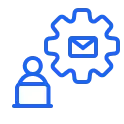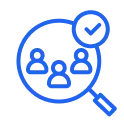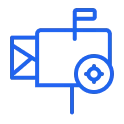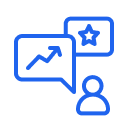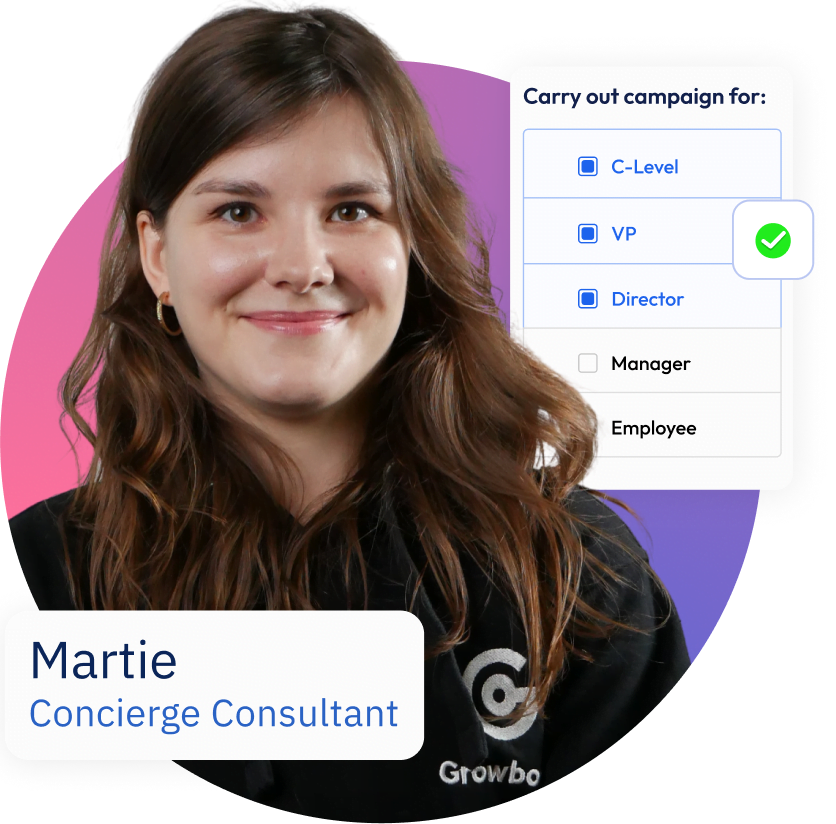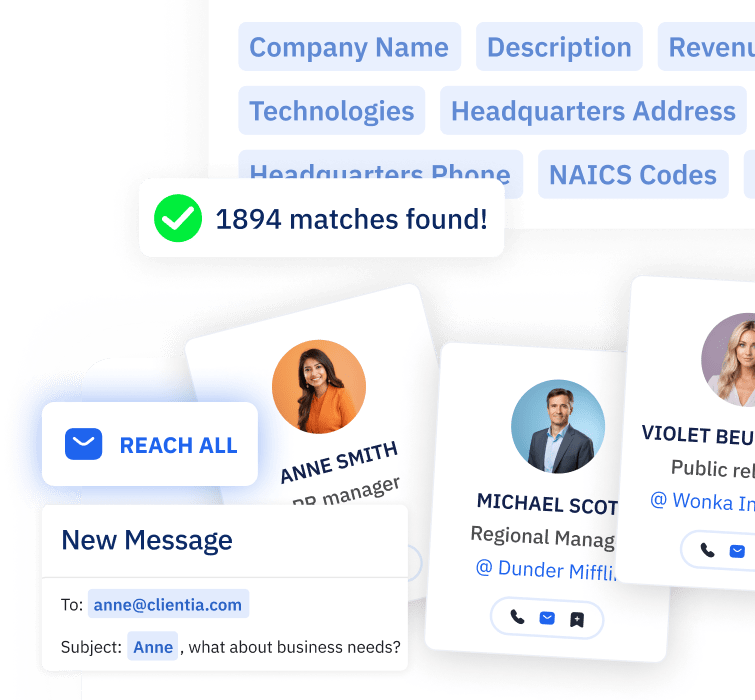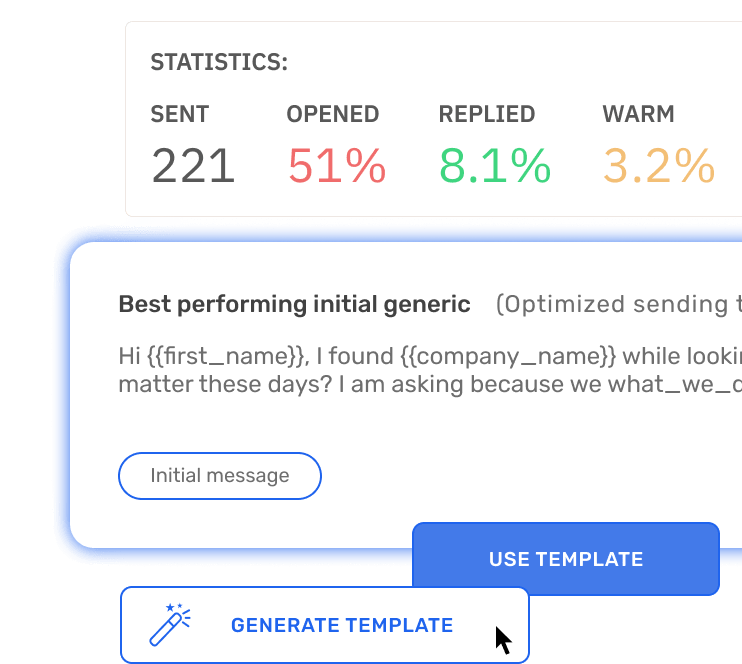A lot of us think we have an idea of who our ideal customer is. Still, a lot of us are chasing bad leads. That’s why we’ve put together an Ideal Customer Profile guide to give you a better idea of what an Ideal Customer Profile template is, how customer profiling works, and why it’s so important to your marketing strategy.
What Is An Ideal Customer Profile?
An Ideal Customer Profile is a useful pattern in sales and marketing. The main reason behind ICP is to define your ideal customer. This means a description of the company that is perfectly suitable for your product or service.
Working with Ideal Customer Profile templates is about finding and determining your best customers who would like to buy your product, are loyal to you and are more likely to refer you to the target audience.
Generally, when the sales team and sales reps decide how to build an Ideal Customer Profile, the main attention should be focused on such features of your target accounts as:
- Industry and niche
- Company size
- Revenue and budget
- Technology stack
- Geographic target market
- Customer base
Why Do You Need An Ideal Customer Profile?
Why should you define your ideal customer profile? First of all, you want your ideas to iterate across your entire organization. With a well-defined target of who your customer is, you can focus the efforts of all of your lead generation channels, be it inbound marketing or outbound sales.
So what is the first step?
Before I answer that, I would like to point out that I am going to use an example from Growbots. It will represent only one of the multiple ideal customer profiles we use.
Think about the product you sell. Here at Growbots, we sell high-quality B2B leads integrated into a quick and easy to use email campaign tool. Our lead search allows our customers to quickly and accurately pinpoint the right leads to target with an outreach campaign.
Why Is An Ideal Customer Profile Important?
Before creating a sales strategy, it is extremely important that sales teams have a deep understanding of the target accounts.
With this information, it becomes much easier to determine where to start and what steps to take to get the desired result. And here the perfect solution is to build an ideal customer profile template.
By analyzing the imaginary company that suits you best and providing customer profiling based on customer data, marketing teams can receive all the necessary information to create an effective marketing strategy that enhances your interaction with both prospective and current customers.
Applying the ICP is essential to define your ideal customer, their needs and expectations, as well as understand how you should proceed to be successful.
With an ideal customer profile, you can:
- Boost your sales outreach
- Use personalized strategies to improve the customer journey
- Increase CLV (customer lifetime value)
- Work with your customer base more efficiently
leave no lead unexplored
Every potential client within reach
- 180m+ contacts
- CRM integrations
- 23 Prospect filters
- 15 Company filters
What’s The Difference Between An Ideal Customer Profile And A Buyer Persona?
Customer profiles and buyer personas are both used during the process of building sales strategies.
That’s why people can often see these terms when seeking customer profile examples. So let’s take a look at both of them.
Even though CP and BP are quite similar at some point, the main difference between them is that:
An Ideal Customer Profile is about an imaginary company that benefits and suits your product or service best. It’s more about the types of businesses you should be working with.
Buyer Personas are fictitious characters that represent your perfect customers. It’s more about using customer profiling to determine who your end buyers are: what their pain points, needs, concerns, wishes, and lifestyles are, and how you can apply this data in your strategies to get the customer feedback you want.
When a sales team creates an ICP, they typically consider both (customer profile and buyer persona) to get a complete picture of the types of companies and buyers your marketing strategy should cover.
In conclusion, an ideal customer profile refers to companies, while buyer persona is all about people.
How To Identify An ICP?
Before you start creating your ideal customer profile template, it’s better first to understand who that ideal customer is.
The best place to start here is with clarifying questions that we can use as filters. This will allow us to get a clearer picture of our target customers.
Answering the following questions may help you identify the ICP in the preparatory phase:
- Which of your current customers brought you the most business and were the best and easiest to communicate with?
- What kind of companies they are?
- Which one of these did you close a deal with the fastest?
- Which one brought you the most profit?
- What are the needs, values and challenges that these companies face?
After answering these questions, you should have a deeper understanding of what type of companies might fit the profile of your ideal customers.
How To Build An Ideal Customer Profile?
After we have a basic idea of what our perfect customers are about, let’s consider the 6 main steps on how to create an Ideal Customer Profile.
Step 1: Write Down Your Best Customers
After you’ve done the groundwork to determine which of your existing customers are easiest for you to do business with, write them down. Then sort and prioritize your best customers according to the following criteria:
- Who is the most profitable?
- Who has worked with you the longest?
- Who is the most enjoyable to work with?
- Who do you have the most contracts with?
- Who most often recommended you to other companies?
These questions are the perfect starting point when you’re trying to define your ideal customer.
Step 2. Do A Thorough Analysis
Analyze the companies on the list and try to answer the following questions:
- Why are these companies your ideal customers?
- Why are these customers cooperating with you for so long or may be interested in such cooperation?
- Why did these customers pay attention to your product and services?
At this stage, it will also be useful to conduct customer profiling to get feedback, as this will allow you to better understand why exactly your customers and buyers value you or are interested in you. The right analysis of customer data leads to the right decisions.
Step 3. Systematize The Collected Information
Once you’ve identified your perfect customers and figured out why they’re there, organize that data. For this purpose, determine what common features they have.
Already at this stage, you can build a basic Ideal Customer template that will give you a clear idea of the image of your ICP.
Step 4: Research Your Customers
By learning the behavioral patterns and habits of your customers, you can develop more personalized marketing and sales strategies.
This approach greatly expands your options and provides a pleasant customer journey for the companies that work with you.
It also gives you a better understanding of your customer’s pain points, needs and expectations, making your ICP template more detailed.
Step 5. Examine Yourself
Knowing your customers is important, but knowing yourself is even more important. Determine the strengths and benefits of your company, products or services.
Then, match the information about your company to the needs and goals of your customers. This allows you to create a deeper connection and understanding of how you may interact with customers.
Knowledge of the main features and ways of cooperation between you and the customer are key to successful sales, effective marketing campaigns, and closed deals.
Step 6. Build Your Template
Once you have all the data you need, create an ICP template that you can use to improve your business and start converting potential customers into actual clients. You can also ask your sales team to do it for you.
Typically, customer profile examples contain the following information about the ICP:
- Industry
- Company size
- Challenges
- Needs
- Technologies
- Annual revenue and budget
- Geographic market
- Growth rate
Seek, pick, and reach
Connect with your potential customers
- 180m+ contacts
- Advanced filtering
- Multichannel sequences
- CRM integrations
How Can Our Example Help You Design An Ideal Customer Profile?
The first thing to do is to look at what your product is and what problem you’re trying to solve. And I mean go deep.
Think about what Growbots sells. The literal things our customers are buying are business leads and software tools. However, in reality, they get much more.
Another way to think about this is from the world of hardware. When you buy a ½ in drill bit, you are really buying a ½ in hole. In other words, your customers are buying a result, not a product.
What Was The Result We Set Out To Sell At Growbots?
Shortly put – the ability to save time and plan for the future.
What does that have to do with leads and emails?
By ensuring the quality of leads fed into an outbound sales process, we have been able to turn revenue generation into a dependable process. In fact, it is dependable enough that you can easily estimate your revenue based on the resources that you put into it.
By streamlining the prospecting process and then integrating it with an automated email tool, the man hours that you need to dedicate to outbound sales is reduced to the point that it can be effectively done by one person.
Essentially our customers are buying the ability to secure their future without having to worry about where they will get the resources to do so.
What kind of result are you trying to achieve? Think about what will be different about your customer after they use your product. Don’t just dwell on the obvious things like higher earnings or an improved process.
After all, there are many ways to skin a cat. Folksy idioms aside, there are many ways to gain revenue or streamline a service.
Your customers are buying the thing that comes after, the thing that happens when their problem is solved, and that’s what both sales reps and sales teams should always keep in mind.
So How Does This Fit Into Your ICP?
Your customers are buying different things even if the product is the same.
- A small startup is buying from us the ability to keep the company alive.
- A larger company is buying from us the ability to match targets.
- Our product is useful to both.
That said, you have to agree that the thing we provide is more critical to the startup, who isn’t bringing in many leads from other channels. So when we were starting out we figured that our ideal customer could be smaller startups. Of course, you might sell a product which fits better with a larger company so how can you test your hypothesis?
Look At The Customers You Have Now
So you have built your product. It is designed to do a specific job for the customer.
But will your sales pitch work?
It’s time to do a study.
Most of our initial sales were made by our CEO. He had an idea of the job our product was supposed to do but at the same time, he was looking for anyone who would like to buy the product.
What was the result?
We developed a scattered data set of who was willing to buy his pitch. By looking at the customers we had, we were able to start seeing correlations in the data. In other words, we saw how they were similar to each other. Here is what we found.
Our best customers were SaaS B2B companies with between 11 and 50 employees. We had success with companies above and below that size but those companies were our bread and butter. Beyond that, we found some interesting correlations which have helped us sell. For instance, we have had much more success with companies that are 4 years old or younger and that have up-to-date websites.
- So what correlations can you find with your customers?
- Do they all match a specific vertical or are they all the same age?
- Do they all happen to use a similar technology or are they in a specific area?
One thing to remember is that because your customers are hiring your product for a specific job, the situation is critical. For instance, a company that is happy with its sales process won’t go for sales automation.
Contrast that with a company that matches the same metrics but has just had two bad quarters. That company will be much more open to a sales automation product than the first company.
So are you ready to fit it all into your ICP? Not yet. There is one more thing that is essential to defining your ideal customer profile.
Red Flags
Just as there are common traits and situations that help you to describe your ideal customer, there are also red flags that you need to steer clear from.
In Growbots’ case, we found that there were a few big ones that could scupper our chances of making a sale. One of the most obvious was if a company was B2C.
Another was a company with a very narrow scope of potential clients. Since our basic package provides 1000 leads a month, customers with only 1000 potential customers would churn through what we could offer them pretty quickly.
Your business might have its own red flags.
Maybe it is a company that uses systems that your product isn’t compatible with. It could also be that they are from a region where you can’t easily offer support. Don’t forget. Your ideal customer is somebody you should be able to sell to easily.
If there are impediments to your sale, you should avoid that customer.
Reach More with Less Effort
Connect with Potential Clients at scale
- AI message generator
- E-mail verification
- Multichannel sequences
- A/B testing
One Example Of Ideal Customer Profile For Growbots
Let’s put it all together. Now is your chance to build your own ideal customer profile. There is another approach you can use by Lincoln Murphy which takes a more broadly philosophical approach to what makes an ideal customer.
Ours incorporates some elements of that but it is more grounded in defining the exact metrics that we want to hit in our ideal customer.
I’ve provided the example of one of the Growbots ICPs. You can use it to see how you can use the information for your ICP.
Problem to solve for customers:_____________
Growbots: Customers need revenue in a timely manner, difficult to start generating leads immediately, don’t know how to do outbound sales
Problem to solve for company:_____________
Growbots: need customer to provide revenue, need customer who will stay on their plan and not churn, customers will refer Growbots to other companies
Willingness and ability:_____________
Growbots: customers who want to engage in outbound sales with automation tools, need customers who can make the decision to buy, can afford a year of our service
Vertical:_____________
Growbots: SaaS, B2B,
Size:_____________
Growbots: 11-50 people
Age:_____________
Growbots: Up to 4 years
Location:_____________
Growbots: North America
Structure:_____________
Growbots: flat structure, still developing hierarchy, less clearly defines sales operation
Special conditions:_____________
Growbots: 10,000 potential leads, need for steady amount of leads to fill funnel, geographic region not as important for the clients.
Pain point:_____________
Growbots: lead pipeline running dry, need to scale operation quickly,
Opportunities:_____________
Growbots: doesn’t know how to scale lead generation, needs to scale leads quickly, need to establish revenue stream
Red Flags:_____________
Growbots: asking for extended free trials, B2C service, narrow range of potential prospects
We should note that this is only one example of an ideal customer profile. As Growbots has developed we have been able to help customers from a number of different verticals who have run into different pain points in their lifecycle.
This is simply an example of one type of customer who we have had success targeting.
Conclusions
By understanding who your ideal customer is, as well as what their challenges, pain points, and goals are, you can create much more effective marketing and sales strategies.
With ideal customer profile templates, it becomes much easier to organize all the collected information and data about the perfect company that suits you best.
When you create a template, you are researching both your customer and yourself. This provides you with a better idea of where you are, where you need to go, and how you can interact with your customers to increase sales and grow your business faster.
This is why ICP is so essential when it comes to building your strategies.
Take full advantage of ideal customer profiles with Growbots to achieve your goals!

Maciej Skoczyński
Account Executive Team Leader at Growbots
